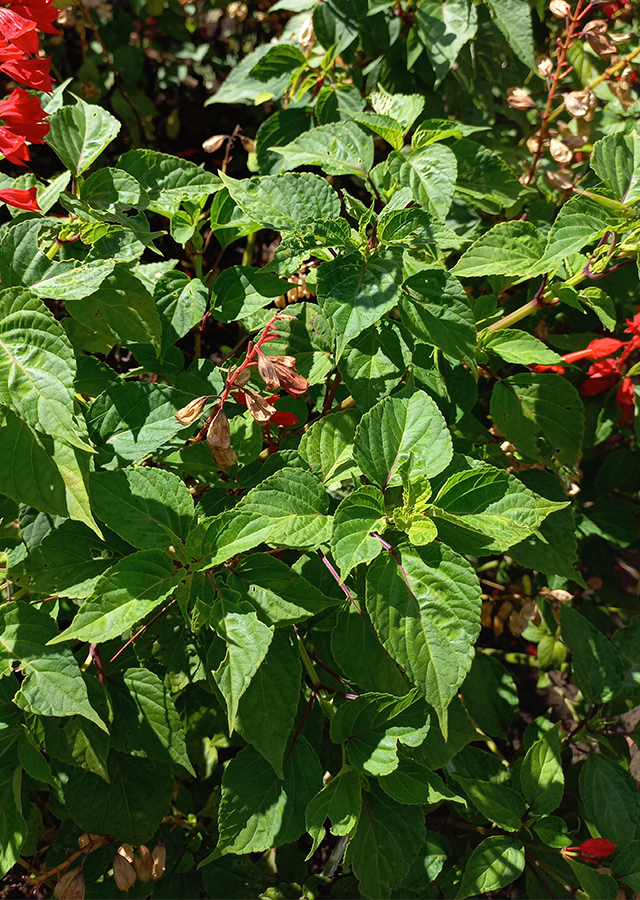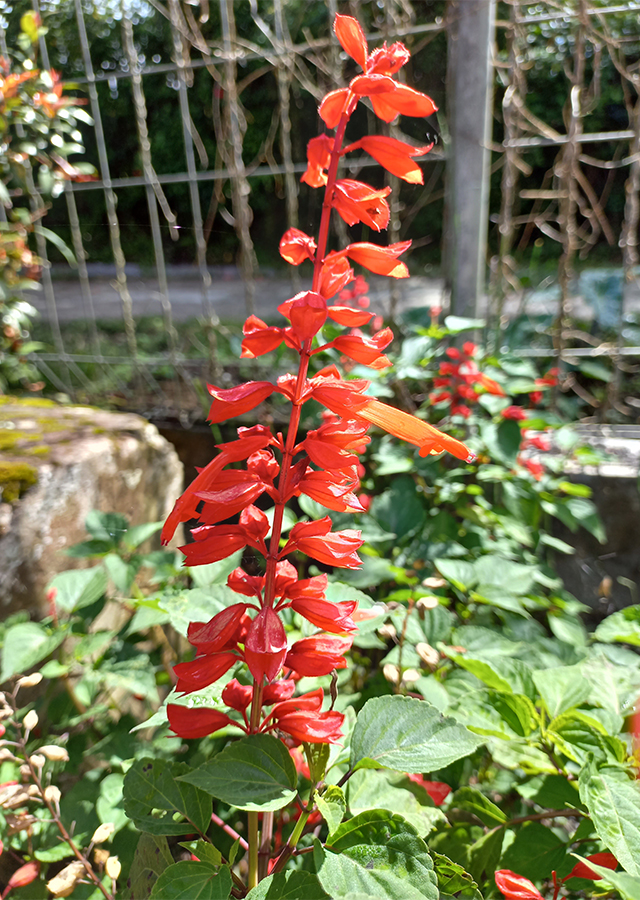Traditional Herbs from Salvia splendens
wound
- Wash fresh leaves of scarlet sage\u00a0until clean.
- Crush it until it becomes a paste.
- Apply it to the injured skin.
soothes_the_stomach_and_heartburn
- Take\u00a05 g fresh roots of scarlet sage, wash thoroughly.
- Boil in 2 glasses of water for 25 minutes.
- Let it cool then strain and drink at once.
What is Salvia splendens Looks like??



Parts of Salvia splendens that could be used
- Leaves", "Seeds", "Roots", "Stems", "All Parts of the Plant
Salvia splendens Distribution
Scarlet sage originates from Brazil and possibly Colombia, although it has been reported as an introduced plant in Colombia. This species was also introduced to the West Indies, Central Africa and most tropical and temperate climates and has been cultivated in the Pacific region. Scarlet sage has bright red flowers and has been introduced to tropical and temperate regions around the world as an ornamental plant. Apart from being an ornamental plant, this plant also has medicinal benefits where this plant is said to be useful for curing diarrhea and removing blocked mucus, it is also considered useful for drying up breast milk for mothers who want to wean their babies.Agroecology of Salvia splendens
Scarlet sage is quite drought tolerant and can grow in a variety of soil types from clay and sand, to acid and loam. This species thrives in full sun in cooler climates but tolerates shade, especially in areas with very hot summers. It prefers average to slightly dry, well-drained soil. This species generally grows in the highlands and lowlands, between 0 and 3000 m above sea level.
Morphology of Salvia splendens
- Taproot, pale brown.
- Stem erect, stem quadrangular, branched and hairy green.
- Leaf stalks 3-4.5 cm, hairless, leaf blades ovate to triangular-ovate, 2.5- 7 \u00d7 2-4.5 cm, hairless, abaxial glandular, base truncated or \u00b1 rounded, edge\u00a0serrate, apex acuminate.
- Flowers 2-6, in racemes reach 20 cm long; bracts ovate, red, enclosing the flower in the bud, apex caudate-acuminate 4-7 mm, calyx red, campanulate, flower size 1.6 cm, expands to 2 cm after anthesis, red glandular, villous veins, 2-lipped to 1/3 long; upper lip triangular-ovate, 5-6 \u00d7 10 mm, apex mucronate; lower lip slightly longer than upper, 2-toothed, corolla dark red, 4-4.2 cm, tube slightly expanded at throat; , oval, 8-9 \u00d7 ca. 4mm; lower lip shorter than upper cm. Nutlets dark brown, ellipsoid\u00a03.5 mm, apex irregularly folded, edge (or central vein) narrowly winged.
- Fruit round, green.
- Seeds kidney shape, small, black.
Cultivation of Salvia splendens
Generative propagation by seeds. Seeds can be sown directly into the ground.
Salvia splendens, more details :
Chemical Content of Salvia splendensAlkaloids, anthocyanins, flavonoids, phenols, glycosides, reducing sugars, saponins, sterols, terpenoids, tannins, and essential oils (phytol, cyclooctasulfur, and 2,2'-methylene-bis[6(1.1-dimethylethyl]-phenol).
Benefits of Salvia splendens
Used in the treatment of diabetes mellitus, to bandage wounds, treat colds, coughs, as a medicine for vomiting, dysentery, colic, hemorrhoids, sprains, swelling, boils, fever, bleeding, nosebleeds.
Simplisia of Salvia splendens
Another Facts for Salvia splendens :
Synonym of Salvia splendensFenixanthes splendens ( Sellow ex Schult.) Raf., Jungia spendens (Sellow ex Schult.) Sojak, Salvia brasiliensis Spreng.
Habitus of Salvia splendens
Herb. Annual herb, up to 90 cm high
Habitat of Salvia splendens
- Roadside
- Land
No comments:
Post a Comment